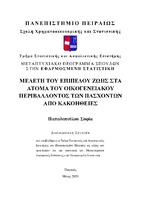Μελέτη του επιπέδου ζωής στα άτομα του οικογενειακού περιβάλλοντος των πασχόντων από κακοήθειες
A study of the quality of life of the relatives of cancer patients

Προβολή/
Λέξεις κλειδιά
Επίπεδο ζωής ; Κακοήθειες ; Οικογενειακό περιβάλλον ; Στατιστική ανάλυση ; Λογιστική παλινδρόμηση ; Ποιότητα ζωήςΠερίληψη
Σκοπός της παρούσας διπλωματικής εργασίας είναι η μελέτη του επιπέδου ζωής στα
άτομα του οικογενειακού περιβάλλοντος των πασχόντων από κακοήθειες. Πιο συγκεκριμένα,
τα άτομα με ασθενείς με καρκίνο στο οικογενειακό τους περιβάλλον συμπλήρωσαν τέσσερα
ερωτηματολόγια που αφορούν την ποιότητα ζωής τους (SF-36,CES-D,STAI-X-1, STAI-X-2),
καθώς και ορισμένα δημογραφικά στοιχεία.
Στην εργασία συμμετείχαν 69 άτομα του οικογενειακού περιβάλλοντος ασθενών με
κακοήθειες από το Γενικό Αντικαρκινικο-Ογκολογικό Νοσοκομείο Αθηνών «Άγιος Σάββας».
Στο δείγμα μας εφαρμόστηκαν κατάλληλοι παραμετρικοί και μη παραμετρικοί έλεγχοι, ο
έλεγχος Χ2 του Pearson, μοντέλα πολλαπλής γραμμικής παλινδρόμησης και μοντέλα
λογιστικής παλινδρόμησης. Επίσης, υπολογίστηκε και ο δείκτης Cronbach’s Alpha.
Τα κυριότερα συμπεράσματα που προέκυψαν από την μελέτη αυτή, αφορούν την
συσχέτιση των δημογραφικών στοιχείων με τις κλίμακες ποιότητας ζωής. Μελετήθηκε ποιοι
από αυτούς τους δημογραφικούς παράγοντες επηρεάζουν κάθε κλίμακα ποιότητας ζωής και
βρέθηκε ότι όταν η συνολική βαθμολογία του SF-36 παίρνει υψηλές τιμές, τότε η βαθμολογία
του CES-D και η συνολική βαθμολογία του STAI παίρνει χαμηλές τιμές. Ακόμη,
παρατηρήθηκε ότι ο χρόνος που ασχολείται κάποιος με τον ασθενή δεν επηρεάζεται από τον
τύπο καρκίνου που έχει ο ασθενής αυτός ούτε από την σχέση που έχουν στην οικογένεια.
Επίσης, αποδείχθηκε ότι η οικογενειακή κατάσταση, η επαγγελματική κατάσταση, η σχέση
με τον ασθενή, η κατάσταση ασφάλισης και η εκπαίδευση αποτελούν στατιστικά
σημαντικούς προγνωστικούς παράγοντες της συνολικής βαθμολογίας του SF-36 (σωματική
και συναισθηματική υγεία). Η επαγγελματική κατάσταση, η σχέση με τον ασθενή και η
εκπαίδευση είναι, σύμφωνα με την μελέτη στατιστικά σημαντικοί προγνωστικοί παράγοντες
της βαθμολογίας του CES-D (κατάθλιψης). Επιπρόσθετα, η οικογενειακή κατάσταση, η
επαγγελματική κατάσταση, η σχέση με τον ασθενή και η εκπαίδευση αποτελούν στατιστικά
σημαντικούς προγνωστικούς παράγοντες της συνολικής βαθμολογίας του STAI
(αυτοεκτίμησης). Βρέθηκε ότι το φύλο, η οικογενειακή κατάσταση και η εκπαίδευση
αποτελούν στατιστικά σημαντικούς προγνωστικούς παράγοντες της χαμηλής φυσικής υγείας
(σύνολο) και της ολικής υγείας (ποιότητας ζωής), ενώ στατιστικά σημαντικοί προγνωστικοί
παράγοντες της χαμηλής ψυχικής υγείας (σύνολο) φαίνεται ότι είναι η οικογενειακή
κατάσταση και η εκπαίδευση. Για την πρόβλεψη των ατόμων σε ρίσκο για κατάθλιψη
στατιστικά σημαντικές μεταβλητές βρέθηκαν ότι είναι το φύλο, η οικογενειακή κατάσταση, η
σχέση με τον ασθενή και η εκπαίδευση. Τέλος, η σχέση με τον ασθενή και η συχνότητα
ασχολίας με τον ασθενή αποτελούν στατιστικά σημαντικούς προγνωστικούς παράγοντες της
εμφάνισης κάποιου επιπέδου άγχους στα άτομα του οικογενειακού περιβάλλοντος των
ασθενών με κακοήθειες.


